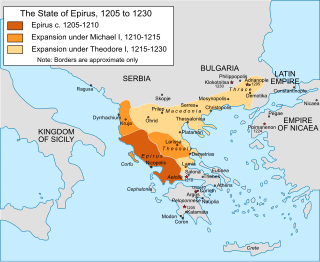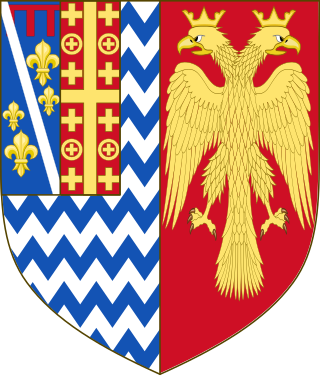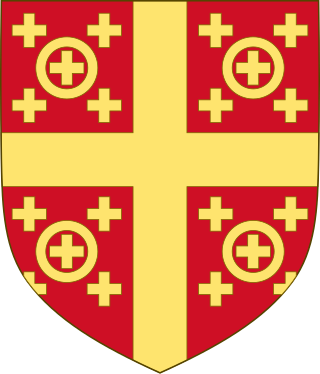
Andronikos III Palaiologos, commonly Latinized as Andronicus III Palaeologus, was the Byzantine emperor from 1328 to 1341. He was the son of Michael IX Palaiologos and Rita of Armenia. He was proclaimed co-emperor in his youth, before 1313, and in April 1321 he rebelled against his grandfather, Andronikos II Palaiologos. He was formally crowned co-emperor in February 1325, before ousting his grandfather outright and becoming sole emperor on 24 May 1328.

Theodore I Laskaris or Lascaris was the first emperor of Nicaea—a successor state of the Byzantine Empire—from 1205 to his death. Although he was born to an obscure aristocratic family, his mother was related to the imperial Komnenos clan. He married Anna, a younger daughter of Emperor Alexios III Angelos in 1200. He received the title of despot before 1203, demonstrating his right to succeed his father-in-law on the throne.

The Latin Empire, also referred to as the Latin Empire of Constantinople, was a feudal Crusader state founded by the leaders of the Fourth Crusade on lands captured from the Byzantine Empire. The Latin Empire was intended to replace the Byzantine Empire as the Western-recognized Roman Empire in the east, with a Catholic emperor enthroned in place of the Eastern Orthodox Roman emperors. The main objective to form a Latin Empire was planned over the course of the Fourth Crusade, promoted by crusade leaders such as Boniface of Montferrat, as well as the Republic of Venice.

The Empire of Nicaea or the Nicene Empire was the largest of the three Byzantine Greek rump states founded by the aristocracy of the Byzantine Empire that fled when Constantinople was occupied by Western European and Venetian armed forces during the Fourth Crusade, a military event known as the Sack of Constantinople. Like the other Byzantine rump states that formed due to the 1204 fracturing of the empire, such as the Empire of Trebizond and the Despotate of Epirus, it was a continuation of the eastern half of the Roman Empire that survived well into the Middle Ages. A fourth state, known in historiography as the Latin Empire, was established by an army of Crusaders and the Republic of Venice after the capture of Constantinople and the surrounding environs.

The Despotate of Epirus was one of the Greek successor states of the Byzantine Empire established in the aftermath of the Fourth Crusade in 1204 by a branch of the Angelos dynasty. It claimed to be the legitimate successor of the Byzantine Empire during the subsequent struggle for Constantinople, along with the Empire of Nicaea and the Empire of Trebizond; its rulers briefly proclaiming themselves as Emperors in 1227–1242. The term "Despotate of Epirus" is, like "Byzantine Empire" itself, a modern historiographic convention and not a name in use at the time.

The Empire of Trebizond or the Trapezuntine Empire was one of the three successor rump states of the Byzantine Empire that existed during the 13th through to the 15th century. The empire consisted of the Pontus, or far northeastern corner of Anatolia, and portions of southern Crimea.
The House of Komnenos, Latinized as Comnenus, was a Byzantine Greek noble family who ruled the Byzantine Empire in the 11th and 12th centuries. The first reigning member, Isaac I Komnenos, ruled from 1057 to 1059. The family returned to power under Alexios I Komnenos in 1081 who established their rule for the following 104 years until it ended with Andronikos I Komnenos in 1185. In the 13th century, they founded the Empire of Trebizond, a Byzantine rump state which they ruled from 1204 to 1461. At that time, they were commonly referred to as Grand Komnenoi, a style that was officially adopted and used by George Komnenos and his successors. Through intermarriages with other noble families, notably the Doukas, Angelos, and Palaiologos, the Komnenos name appears among most of the major noble houses of the late Byzantine world.

The despot of Epirus was the ruler of the Despotate of Epirus, one of the successor states of the Byzantine Empire in the aftermath of the Fourth Crusade. The name "Despotate of Epirus" and the title "despot of Epirus" are modern historiographical names, and were not in use by the despots themselves. In the Byzantine Empire, the title of despot was a prestigious court title and did not designate rule over some specific territory. Though several of the early Greek rulers of the Epirote realm did use the title of despot, it was never in reference to the lands they governed, but instead in reference to their position in the imperial hierarchy.

Michael I Komnenos Doukas, Latinized as Comnenus Ducas, and in modern sources often recorded as Michael I Angelos, a name he never used, was the founder and first ruler of the Despotate of Epirus from c. 1205 until his assassination in 1214/15.
Anna Anachoutlou ruled the Empire of Trebizond from 1341 to 1342. She was the eldest daughter of the Trapezuntine emperor Alexios II Megas Komnenos and had joined a convent as a nun during her father's reign. After the death of her father, Anna's brother Andronikos III, her nephew Manuel II and her other brother Basil reigned in rapid succession. After Basil's death, his widow Irene Palaiologina, genealogically unconnected to the ruling Grand Komnenos dynasty of Trebizond, seized power as empress regnant. In June/July 1341, Anna escaped from her convent and rapidly began rallying support to fight against Irene. Despite being a woman and up until recently a nun, and there being several possible male heirs of her dynasty, Anna attracted considerable support from the provincials of the empire, from ethnic minorities such as the Laz and Zan peoples, and from Georgian soldiers, either mercenaries or forces sent by King George V of Georgia.

Theodore Komnenos Doukas or Theodore Angelos Komnenos was the ruler of Epirus and Thessaly from 1215 to 1230 and of Thessalonica and most of Macedonia and western Thrace from 1224 to 1230. He was also the power behind the rule of his sons John and Demetrios over Thessalonica in 1237–1246.
Demetrios Angelos Doukas, was ruler of Thessalonica with the title of Despot as a vassal of the Empire of Nicaea from 1244 until his deposition in 1246.
The House of Angelos, Latinised as Angelus, was a Byzantine Greek noble family that produced several Emperors and other prominent nobles during the middle and late Byzantine Empire. The family rose to prominence through the marriage of its founder, Constantine Angelos, with Theodora Komnene, the youngest daughter of Emperor Alexios I Komnenos. As imperial relatives, the Angeloi held various high titles and military commands under Emperor Manuel I Komnenos. In 1185, following a revolt against Andronikos I Komnenos, Isaac II Angelos rose to the throne establishing the Angeloi as the new imperial family that ruled until 1204. The period was marked by the decline and fragmentation of the Byzantine Empire, culminating in its dissolution by the Fourth Crusade in 1204 under Alexios IV Angelos.

The Latin Emperor was the ruler of the Latin Empire, the historiographical convention for the Crusader realm, established in Constantinople after the Fourth Crusade (1204) and lasting until the city was reconquered by the Byzantine Greeks in 1261. Its name derives from its Catholic and Western European ("Latin") nature. The empire, whose official name was Imperium Romaniae, claimed the direct heritage of the Eastern Roman Empire, which had most of its lands taken and partitioned by the crusaders. This claim however was disputed by the Byzantine Greek successor states, the Empire of Nicaea, the Empire of Trebizond and the Despotate of Epirus. Out of these three, the Nicaeans succeeded in displacing the Latin emperors in 1261 and restored the Byzantine Empire.

Theodora Petraliphaina, canonized as Saint Theodora of Arta, was a consort of Epirus and an Orthodox Christian saint.

The Empire of Thessalonica is a historiographic term used by some modern scholars to refer to the short-lived Byzantine Greek state centred on the city of Thessalonica between 1224 and 1246 and ruled by the Komnenodoukas dynasty of Epirus. At the time of its establishment during the struggle for Constantinople, the Empire of Thessalonica, under the capable Theodore Komnenos Doukas, rivaled the Empire of Nicaea and the Second Bulgarian Empire as the strongest state in the region, and aspired to capturing Constantinople, putting an end to the Latin Empire, and restoring the Byzantine Empire that had been extinguished in 1204.

The struggle for Constantinople was a complex series of conflicts following the dissolution of the Byzantine Empire in the aftermath of the Fourth Crusade in 1204, fought between the Latin Empire established by the Crusaders, various Byzantine successor states, and foreign powers such as the Second Bulgarian Empire and Sultanate of Rum, for control of Constantinople and supremacy within the former imperial territories.
The Treaty of 1282 was an agreement between Empire of Trebizond and the Byzantine Empire. It was signed by emperors John II of Trebizond and Michael VIII Palaiologos.



















